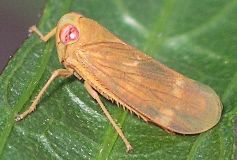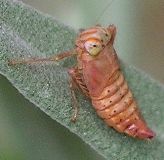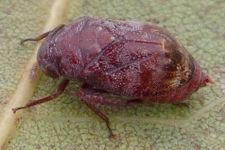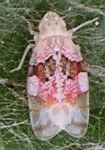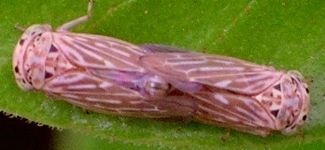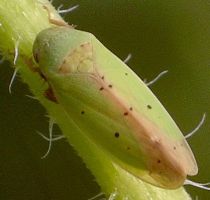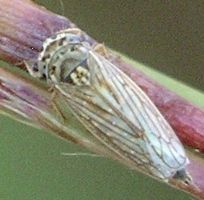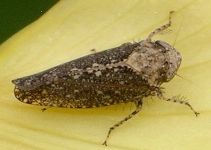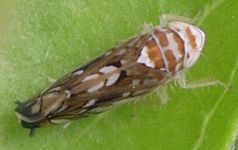
| Cicadellidae ~ Leafhoppers |
page 1 ![]() page 2
page 2
|
The majority of leafhoppers have heads which are sort of flat, and that is one feature that helps distinguish them from planthoppers. Coelidia olitoria, though, has a deep face and I think that it looks more like insects in other families than its fellow leafhoppers. Color ranges from dark brown to golden, with a sort of dusty grayish appearance, and females have vague bands on their wings. The nymphs of this genus are often called froghoppers because of their squat appearance and the way they sit upright and hold their tails up.
While we're discussing un-leafhopper-like appearances, Penthimia americana really takes the cake. This rotund little beast looks very similar to some members of the spittlebug family, and it does not resemble any other leafhoppers. This species rarely jumps or flies away and more often just sits tight and tries to remain unnoticed. Length is about 4 mm.
Leafhoppers can diverge from the typical shape in width also. Hymetta balteata holds its wings more open than most leafhoppers, giving it a wider appearance. It is tiny, but the intricate colors and glassy looking wings are lovely if you can see it magnified. Species in the genus Idiocerus have very short and rounded faces. Their heads are quite wide. I've not seen many of these so they probably are not too common. They are another very small species that can easily be overlooked. Members of the genus Draeculacephala are medium-sized and green. They have very pointy and flattened heads. Prairiana orizaba looks very much like them but is brown.
A good number of leafhoppers are green, but they almost all have other identifying features. This Ponana species has small black dots and a rounded shape. The intricate designs on Exitianus exitiosus are its identifiers, including the tiny markings on the head.
Some leafhoppers have incredibly intricate markings which, unless magnified, tend to make the insects look like bits of debris. The fine network of lines on Scaphytopius species, along with tiny size and pointy head, help distinguish it. Texananus species are a larger and have a light colored head and paired spots going down the center of the back. The unknown leafhopper pictured next to it might appear to be very similar, but it doesn't quite match and it might be related or not.
Besides nice markings that make identification easy, Scaphoideus species have bristles on the tips of their abdomens. These are often just barely visible beyond the wings, sticking out at right angles. I like gaudy iridescent colors, so to me one of the prettiest leafhoppers is Stirellus bicolor. I've only noticed the ones that are metallic green and black, but it comes in another color form that is an unremarkable brown.
Very common, but easy to overlook, there are numerous tiny pale green species of leafhoppers. I'm not terribly sure of my identifications here, but I've checked out as many as I could and narrowed it down to these possibilities: the mating pair of Empoasca species are narrow, have large white eyes, and show faint white markings on their head and thorax. I'm going more by head shape and eye size for the Dikraneura species.
The tiny polka dot Trypanalebra maculata are about the tiniest leafhoppers I've managed to photograph; they are host specific, being found only on Velvet-leaf Mallow (Wissadula holosericea). Even with their bold coloration, they are so small as to be almost invisible unless approached very closely. The short-winged leafhopper could belong to a number of genera that demonstrate this trait.
|
page 1 ![]() page 2
page 2
![]()
